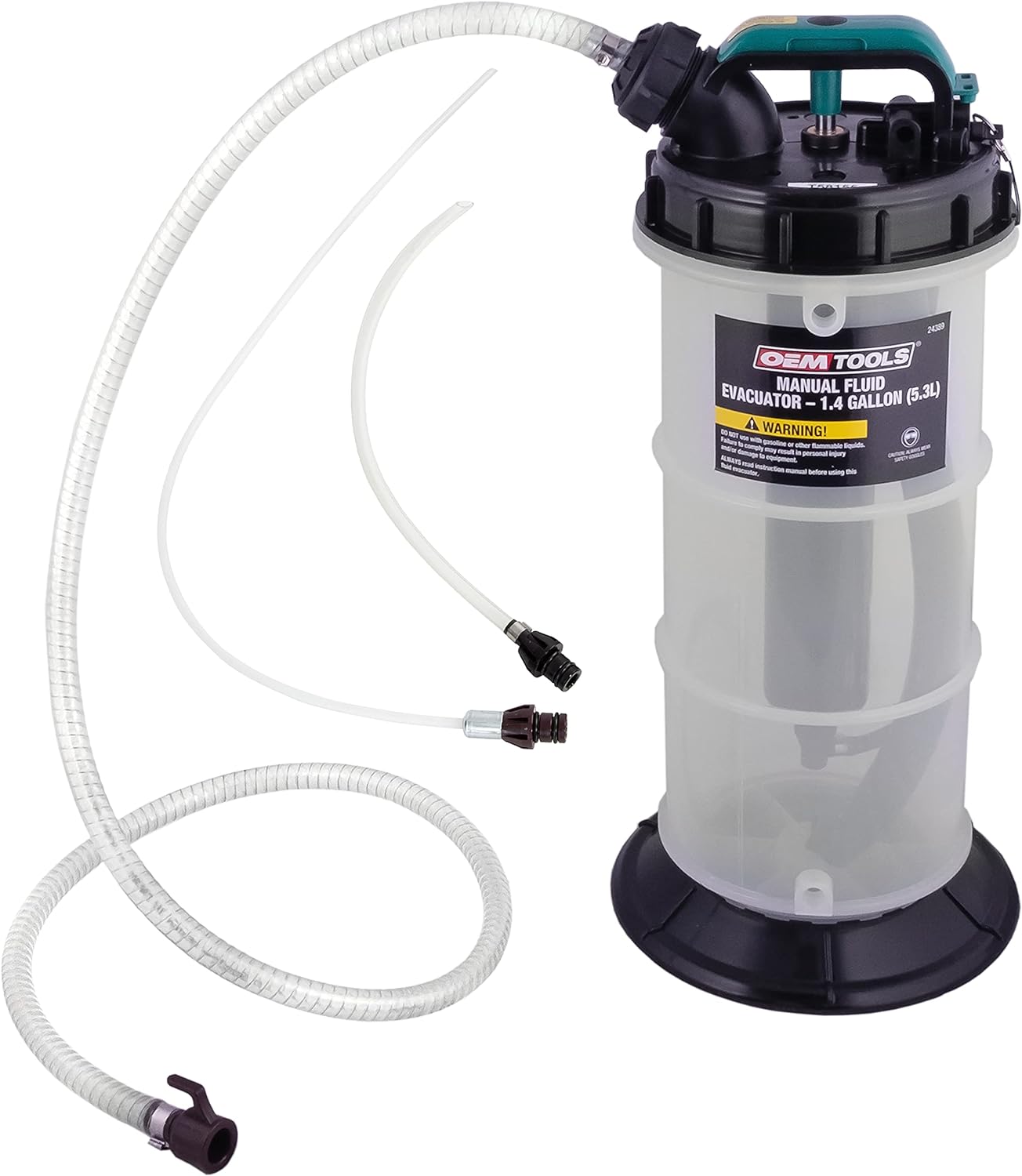

Oil changes aren’t complicated, it’s just the fact that you’re going to get oil everywhere that’s keeping you from jumping on it. Even with a nice catch can and funnel, oil somehow finds a way to wind up in places it shouldn’t. An oil extractor pump just might be the perfect way to put your oil change woes behind you.
These devices reach down into the pan through the dipstick tube, letting you skip right past the drama of laying flat on your back at the mercy of the designers who crammed that drain plug in the worst place possible. You know you’re on board. You just need to find out which model of oil extractor pump fits into your life. That’s what I’m here to help you with.
Oil extractor pumps are easy to understand. It doesn’t take much to get yourself in the right ballpark. Still, it helps to do a little bit of homework. It’s important to know what the basic functions of the different types are as well as what brands are worthy of your consideration in this segment. It’s also a good idea to always read the reviews of any product you’re considering to make sure that specific model is effective. I took those factors into account and balanced them with what I know to be important to the average DIYer when building the buying guide and list of recommendations.
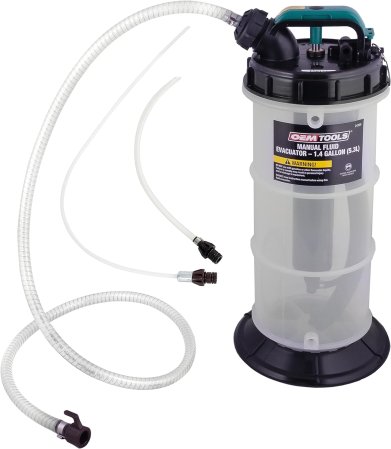
OEMTools is a name easily recognizable to the DIY mechanic, and it’s no surprise to see it take the pick for Best Overall. The balance of price and quality is just what you’d expect from the brand and this pump is built to serve the average gearhead well. It’s also working with a large hand pump to improve comfort, a 5.3-liter reservoir holds more than enough oil without becoming unwieldy, and quick-connect hoses make setup simple. OEM Tools has equipped it with an automatic shut-off to keep overflowing, keeping your garage floor clean.
As for the potential downsides, the included hoses are a little short for trucks and other larger vehicles. Also, the base does lack stability and you can easily tip it over if you’re not careful.
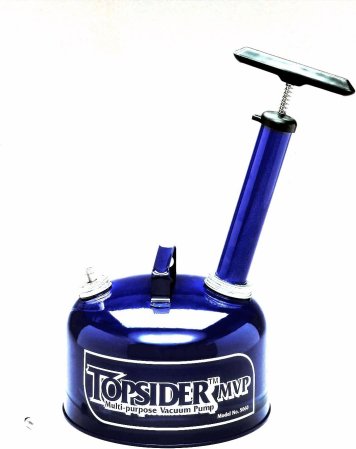
The deceiving size of the Airpower America FloTool is one major reason it takes the spot for Best Value. Despite initial impressions, it’s able to hold up to eight quarts, or just over 7.5 liters of oil. That’s not all it has to offer, though. The steel body offers maximum durability, its oversized handle makes operation easy, and not needing continuous pumping keeps your nerves intact during use. All of that packed into a compact footprint at a budget-friendly price makes it hard for anything to compete with this oil extraction pump.
It does have some drawbacks, though. The odd shape is not great for storage and can be a hassle for some. The pump must be removed for draining the extractor when full. It’s also worth knowing that one can easily overtighten the lid and create seal issues for the system.
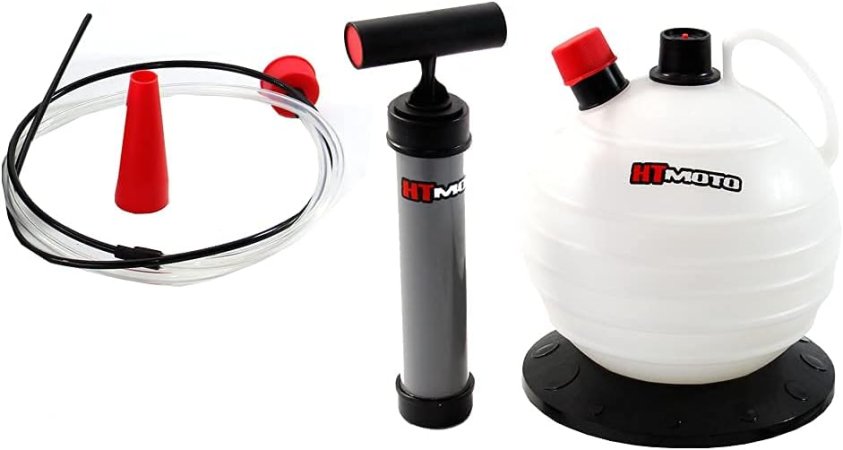
HT Moto’s oil extractor pump makes for the second uniquely shaped extractor pump on our list. It has a small footprint but can hold up to six liters of oil. It’s designed to get fluid flowing with a dozen pumps, and your workout is over once it starts. The pump can also be removed to aid with storage, which is good considering that the round body alone can pose issues in this area. It also includes a spout to make draining easy.
The pump functions well, but it’s on the delicate side. The plastic body tends to collapse in on itself if you over pump the system, and the seals tear easily. It’s also worth mentioning that it’s nearly double the cost of similar units built with sturdier materials.
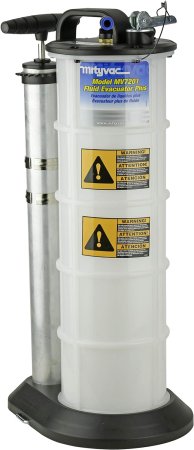
You can’t talk about oil extractor pumps without mentioning Mityvac, especially when it offers this titan of a unit. Its 8.7-liter capacity makes it an excellent choice for vehicle owners conducting multiple oil changes at once. It’s also a true performer that features a large manual pump to get fluid going, with no need for power or compressed air. It can also change flow with the push of a button, changing it from vacuum to pressure. That means you can use this unit to fill your machines after draining them. Of course, the quality is there to back it as a solid tool investment for any shop owner.
It doesn’t take the top spot on this list because of the high price. Also, the included hoses are a bit short for larger vehicles, which may come as a surprise considering the capacity.
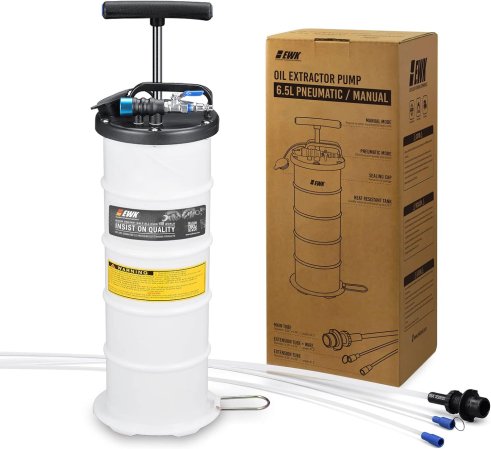
The list is closing with another close contender for Best Overall. What really makes this model stand out is the ability to extract fluid with both manual and pneumatic power. That kind of flexibility puts it in a league of its own, and you really can’t go wrong with this over the others because of it. It’s also working with a solid capacity for any shop owner, has a high flow rate, and is priced less than some other models with fewer features, making for an excellent value.
All that’s holding it back from our top pick is the slow flow rate when operated manually. Folks without an air compressor will want to go with something quicker when operated manually. It’s also only fair to mention that the included hoses are delicate, so you need to be careful not to break them.
OEMTools Manual Liter Extractor takes our top pick due to the balance of price and reliability as well as its practical design. However, the Air Power America Fluid Removing System is another excellent choice, which happens to be priced to fit within any budget.
As the name suggests, manual pumps have you doing the work. That’s not to say they’re all the same, though. Some designs require you to pump the system to extract oil with each stroke, while others let a vacuum build up from pumping to do the work. Manual pumps may require user input that other designs do not, but that does come at an advantage. No dependence on external power sources means you’re free to use this style of pump in virtually any situation.
Pneumatic oil extractors let compressed air do the work. That means you don’t need to work up a sweat to suck the oil out of the crankcase. Just set up the extractor with a few airlines, step back, and let it handle the situation for you. Obviously, these are great for shops already equipped with a good air compressor. Otherwise, the overall investment to make this type of oil extractor pump operational simply isn’t worth it.
Electric pumps are an alternative many will consider. Rather than using manual input or compressed air to work, an electric motor is used to extract oil. Depending on the model you select, it can use 12-volt or 120-volt power. The obvious benefit is that they don’t require as much work from the user, nor do they depend on expensive equipment to function. However, they are limited in availability, and performance isn’t always the best.
Portability and capacity go hand in hand. Oil extractor pumps are designed to make transport easy in some way. However, as the capacity increases, the size, and weight when full — if a reservoir is present — will increase. You want to make sure you consider your intended use and pick a model you can use without it being a hassle.
Look for safety features to ensure that you have a clean extraction process. Features like a flow control valve and automatic shut-off for immediately stopping the flow of oil to prevent overflowing can save you a mess and potential injury. Another good feature is a suction pipe that directs the oil from the engine to the disposal container. This simple feature makes disposing of the extracted oil as easy as removing it from the crankcase.
As mentioned before, size and reservoir capacity directly correlate. No matter the case, though, you must pick a reservoir that’ll hold the oil it’s pulling from the engine. Otherwise, you’ll have to stop and empty it out in the middle of a job. Most pump reservoirs can hold five to 10 liters of oil. You should pick a size that at least matches the oil capacity of your vehicle’s engine.
The majority of oil extractor pumps sell for around $50 to $100. The better models general list in the range of $80-$100 with many exceeding that upper limit. You can find plenty of viable models on the lower end, but the lower price does generally come at the exchange of quality and features.
You’ve got questions. The Drive has answers.
Q: How do you empty an oil extractor?A: It depends on the model. Some require the fluid to be poured out, others have a drain port, and some even pump it out. It’s worth reading into this detail before you buy to ensure you select a system you’re comfortable with.
Q: What happens if you overfill your engine’s oil?A: Too much oil can lead to foaming. This inhibits the oil’s ability to function properly and can eventually lead to internal damage.
Q: Will an oil extractor pump hurt my engine?A: No. An oil extractor pump will not hurt your engine. As long as you set it up and run it correctly, you won’t run into any issues.
Q. Where do I recycle my old oil?A: Your local auto parts supplier that you buy oil from likely accepts oil for recycling. Big chain retailers are usually a safe bet that will save you the trouble of searching for a nearby oil bank.

Associate Editor, Commerce
Hank is an Associate Editor at The Drive. He may be here to recommend tools and parts, but he’s always happy to dive deep into tech discussions, especially when it gives him the opportunity to display his old Dodge.